window FIAT DOBLO COMBI 2012 Owner handbook (in English)
[x] Cancel search | Manufacturer: FIAT, Model Year: 2012, Model line: DOBLO COMBI, Model: FIAT DOBLO COMBI 2012Pages: 283, PDF Size: 6.31 MB
Page 142 of 283
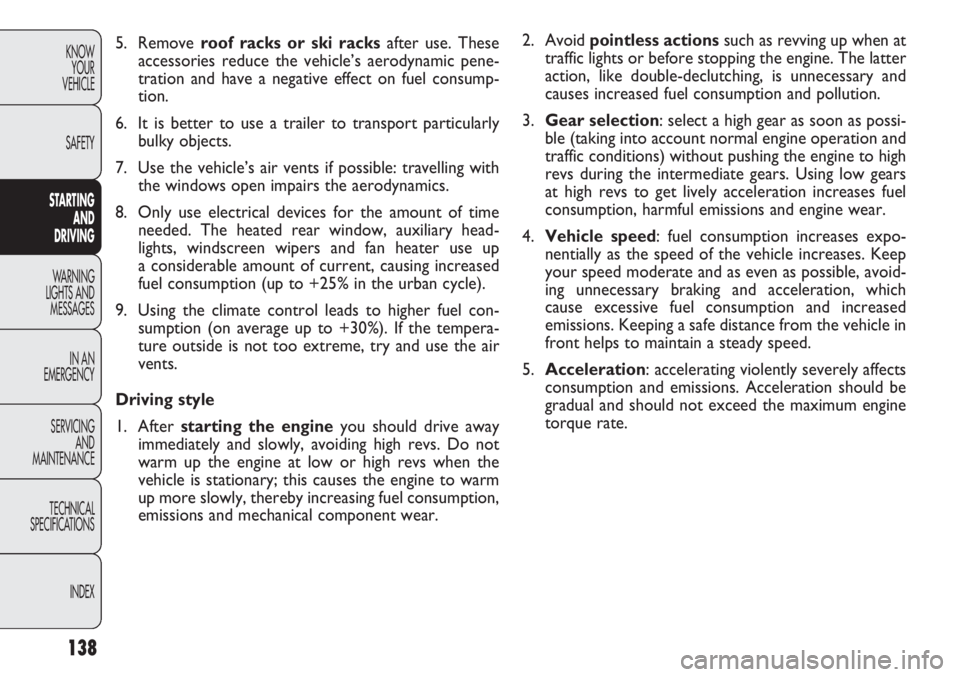
138
KNOWYOUR
VEHICLE
SAFETY
ST ARTING
AN
D
DRIVING
WARNING
LIGHTS AND MESSAGES
IN AN
EMERGENCY
SERVICING AND
MAINTENANCE
TECHNICAL
SPECIFICA TIONS
INDEX
2. Avoid pointless actions such as revving up when at
traffic lights or before stopping the engine. The latter
action, like double-declutching, is unnecessary and
causes increased fuel consumption and pollution.
3. Gear selection: select a high gear as soon as possi-
ble (taking into account normal engine operation and
traffic conditions) without pushing the engine to high
revs during the intermediate gears. Using low gears
at high revs to get lively acceleration increases fuel
consumption, harmful emissions and engine wear.
4. Vehicle speed: fuel consumption increases expo-
nentially as the speed of the vehicle increases. Keep
your speed moderate and as even as possible, avoid-
ing unnecessary braking and acceleration, which
cause excessive fuel consumption and increased
emissions. Keeping a safe distance from the vehicle in
front helps to maintain a steady speed.
5. Acceleration: accelerating violently severely affects
consumption and emissions. Acceleration should be
gradual and should not exceed the maximum engine
torque rate.
5. Remove
roof racks or ski racks after use. These
accessories reduce the vehicle’s aerodynamic pene-
tration and have a negative effect on fuel consump-
tion.
6. It is better to use a trailer to transport particularly bulky objects.
7. Use the vehicle’s air vents if possible: travelling with the windows open impairs the aerodynamics.
8. Only use electrical devices for the amount of time needed. The heated rear window, auxiliary head-
lights, windscreen wipers and fan heater use up
a considerable amount of current, causing increased
fuel consumption (up to +25% in the urban cycle).
9. Using the climate control leads to higher fuel con- sumption (on average up to +30%). If the tempera-
ture outside is not too extreme, try and use the air
vents.
Driving style
1. After starting the engine you should drive away
immediately and slowly, avoiding high revs. Do not
warm up the engine at low or high revs when the
vehicle is stationary; this causes the engine to warm
up more slowly, thereby increasing fuel consumption,
emissions and mechanical component wear.
Page 146 of 283
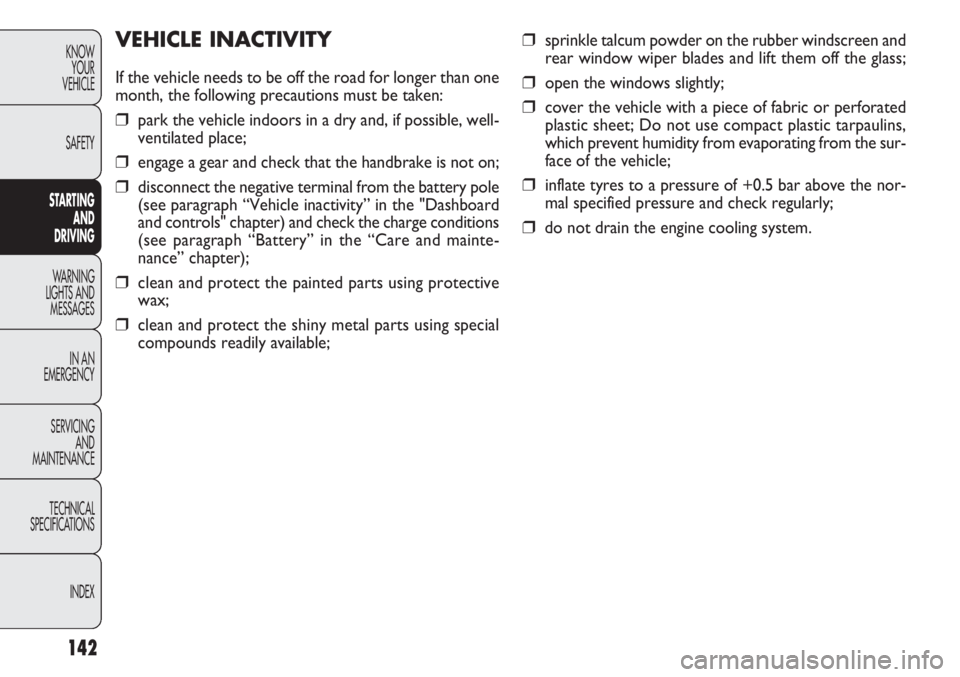
142
KNOWYOUR
VEHICLE
SAFETY
ST ARTING
AN
D
DRIVING
WARNING
LIGHTS AND MESSAGES
IN AN
EMERGENCY
SERVICING AND
MAINTENANCE
TECHNICAL
SPECIFICA TIONS
INDEX
❒sprinkle talcum powder on the rubber windscreen and
rear window wiper blades and lift them off the glass;
❒open the windows slightly;
❒cover the vehicle with a piece of fabric or perforated
plastic sheet; Do not use compact plastic tarpaulins,
which prevent humidity from evaporating from the sur-
face of the vehicle;
❒inflate tyres to a pressure of +0.5 bar above the nor-
mal specified pressure and check regularly;
❒do not drain the engine cooling system.
VEHICLE INACTIVITY
If the vehicle needs to be off the road for longer than one
month, the following precautions must be taken:
❒park the vehicle indoors in a dry and, if possible, well-
ventilated place;
❒engage a gear and check that the handbrake is not on;
❒disconnect the negative terminal from the battery pole
(see paragraph “Vehicle inactivity” in the "Dashboard
and controls" chapter) and check the charge conditions
(see paragraph “Battery” in the “Care and mainte-
nance” chapter);
❒clean and protect the painted parts using protective
wax;
❒clean and protect the shiny metal parts using special
compounds readily available;
Page 187 of 283
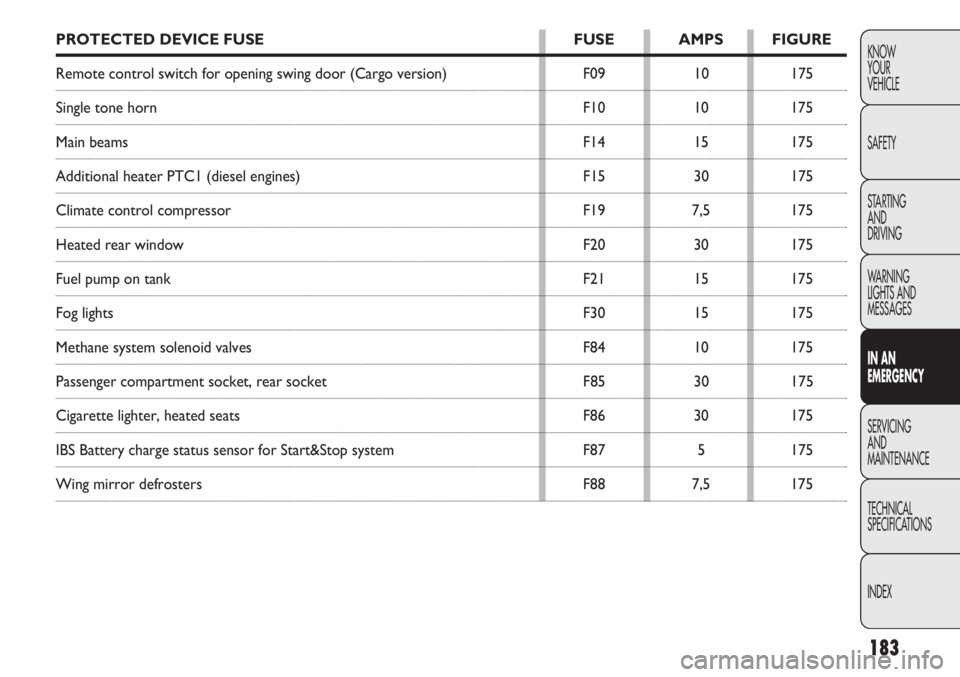
183
KNOW
YOUR
VEHICLE
SAFETY
STARTING
AND
DRIVING
WARNING
LIGHTS AND
MESSAGES
IN AN
EMERGENCY
SERVICING
AND
MAINTENANCE
TECHNICAL
SPECIFICATIONS
INDEXPROTECTED DEVICE FUSE FUSE AMPS FIGURE
Remote control switch for opening swing door (Cargo version) F0910175
Single tone horn F1010175
Main beams F1415175
Additional heater PTC1 (diesel engines) F1530175
Climate control compressor F197,5175
Heated rear window F2030175
Fuel pump on tank F2115175
Fog lights F3015175
Methane system solenoid valves F8410175
Passenger compartment socket, rear socket F8530175
Cigarette lighter, heated seats F8630175
IBS Battery charge status sensor for Start&Stop system F875175
Wing mirror defrosters F887,5175
Page 189 of 283
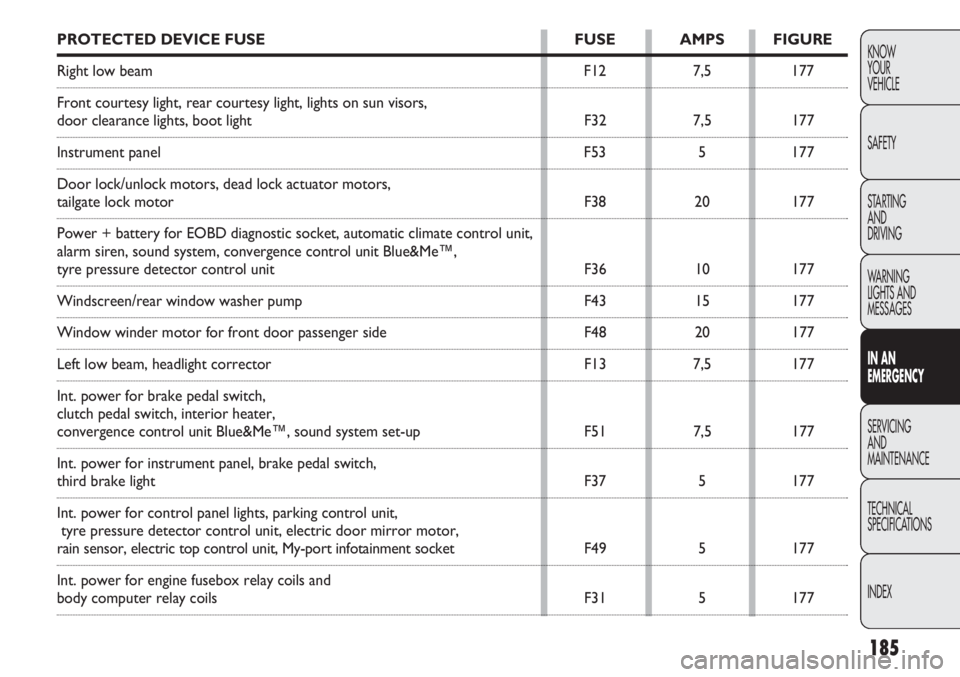
185
KNOW
YOUR
VEHICLE
SAFETY
STARTING
AND
DRIVING
WARNING
LIGHTS AND
MESSAGES
IN AN
EMERGENCY
SERVICING
AND
MAINTENANCE
TECHNICAL
SPECIFICATIONS
INDEXPROTECTED DEVICE FUSE FUSE AMPS FIGURE
Right low beam F127,5177
Front courtesy light, rear courtesy light, lights on sun visors,
door clearance lights, boot light F327,5177
Instrument panel F535177
Door lock/unlock motors, dead lock actuator motors,
tailgate lock motor F3820177
Power + battery for EOBD diagnostic socket, automatic climate control un\
it,
alarm siren, sound system, convergence control unit Blue&Me™,
tyre pressure detector control unit F3610177
Windscreen/rear window washer pump F4315177
Window winder motor for front door passenger side F4820177
Left low beam, headlight corrector F137,5177
Int. power for brake pedal switch,
clutch pedal switch, interior heater,
convergence control unit Blue&Me™, sound system set-up F517,5177
Int. power for instrument panel, brake pedal switch,
third brake light F375177
Int. power for control panel lights, parking control unit, tyre pressure detector control unit, electric door mirror motor,
rain sensor, electric top control unit, My-port infotainment socket F495177
Int. power for engine fusebox relay coils and
body computer relay coils F315177
Page 190 of 283
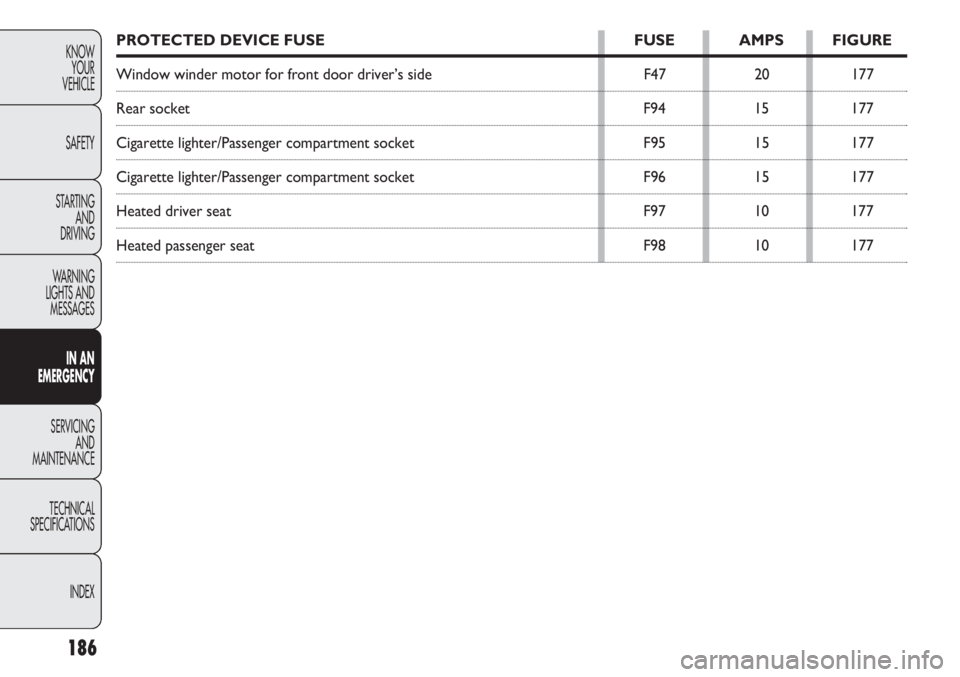
186
KNOWYOUR
VEHICLE
SAFETY
STARTING AND
DRIVING
WARNING
LIGHTS AND MESSAGES
IN AN
EMERGENCY
SERVICING AND
MAINTENANCE
TECHNICAL
SPECIFICA TIONS
INDEXPROTECTED DEVICE FUSE FUSE AMPS FIGURE
Window winder motor for front door driver’s side F4720177
Rear socket F9415177
Cigarette lighter/Passenger compartment socket F9515177
Cigarette lighter/Passenger compartment socket F9615177
Heated driver seat F9710177
Heated passenger seat F9810177
Page 196 of 283
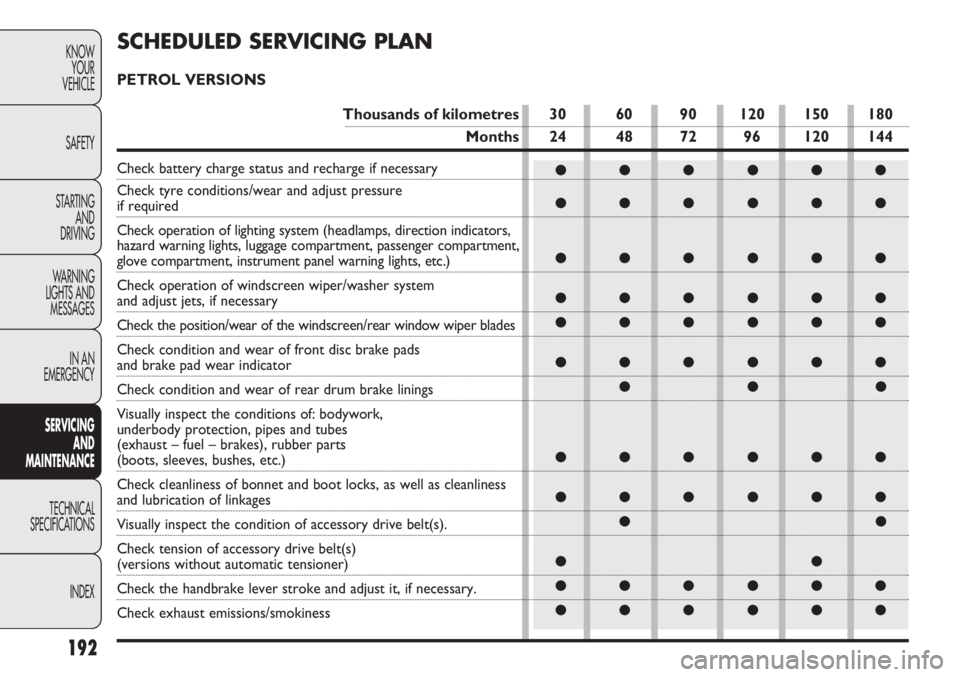
192
KNOWYOUR
VEHICLE
SAFETY
STARTING AND
DRIVING
WARNING
LIGHTS AND MESSAGES
IN AN
EMERGENCY
SERV IC
ING
AND
MAINTENANCE
TECHNICAL
SPECIFICA TIONS
INDEX
●●●●●●
●●●●●●
●●●●●●
●●●●●●
●●●●●●
●●●●●● ●●●
●●●●●●
●●●●●● ●●
●●
●●●●●●
●●●●●●
SCHEDULED SERVI CING PLAN
PETROL VERSIONS
Thousands of kilometres 30 60 90 120 150 180
Months 24 48 72 96 120 144
Check battery charge status and recharge if necessary
Check tyre conditions/wear and adjust pressure
if required
Check operation of lighting system (headlamps, direction indicators,
hazard warning lights, luggage compartment, passenger compartment,
glove compartment, instrument panel warning lights, etc.)
Check operation of windscreen wiper/washer system
and adjust jets, if necessary
Check the position/wear of the windscreen/rear window wiper blades
Check condition and wear of front disc brake pads
and brake pad wear indicator
Check condition and wear of rear drum brake linings
Visually inspect the conditions of: bodywork,
underbody protection, pipes and tubes
(exhaust – fuel – brakes), rubber parts
(boots, sleeves, bushes, etc.)
Check cleanliness of bonnet and boot locks, as well as cleanliness
and lubrication of linkages
Visually inspect the condition of accessory drive belt(s).
Check tension of accessory drive belt(s)
(versions without automatic tensioner)
Check the handbrake lever stroke and adjust it, if necessary.
Check exhaust emissions/smokiness
Page 202 of 283
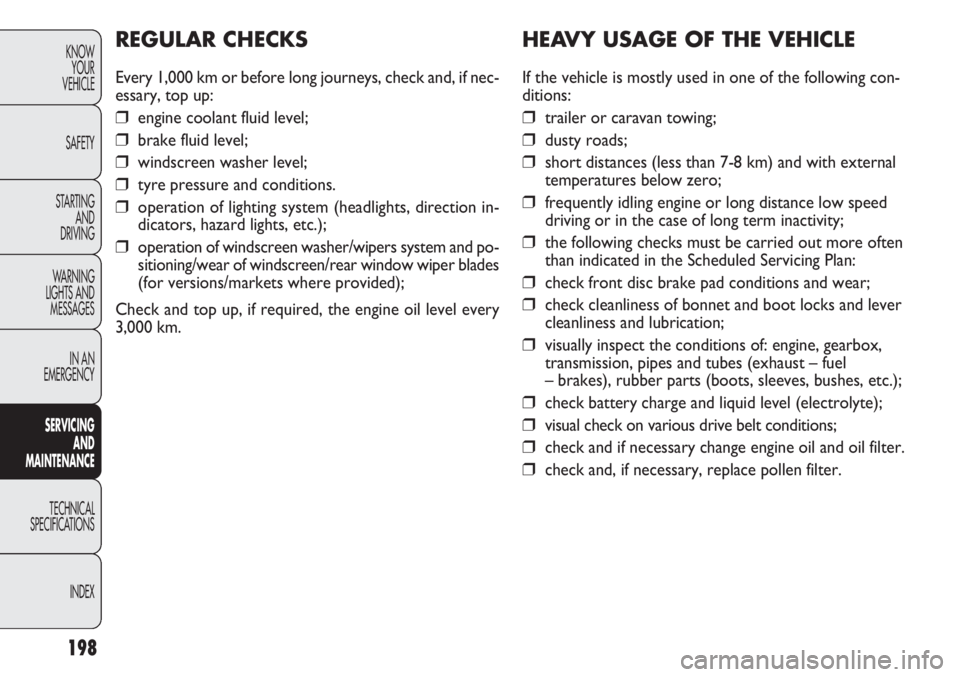
198
KNOWYOUR
VEHICLE
SAFETY
STARTING AND
DRIVING
WARNING
LIGHTS AND MESSAGES
IN AN
EMERGENCY
SERV IC
ING
AND
MAINTENANCE
TECHNICAL
SPECIFICA TIONS
INDEX
HEAV Y USAGE OF THE VEHICLE
If the vehicle is mostly used in one of the following con-
ditions:
❒trailer or caravan towing;
❒dusty roads;
❒short distances (less than 7-8 km) and with external
temperatures below zero;
❒frequently idling engine or long distance low speed
driving or in the case of long term inactivity;
❒the following checks must be carried out more often
than indicated in the Scheduled Servicing Plan:
❒check front disc brake pad conditions and wear;
❒check cleanliness of bonnet and boot locks and lever
cleanliness and lubrication;
❒visually inspect the conditions of: engine, gearbox,
transmission, pipes and tubes (exhaust – fuel
– brakes), rubber parts (boots, sleeves, bushes, etc.);
❒check battery charge and liquid level (electrolyte);
❒visual check on various drive belt conditions;
❒check and if necessary change engine oil and oil filter.
❒ check and, if necessary, replace pollen filter.
REGULAR CHECKS
Every 1,000 km or before long journeys, check and, if nec-
essary, top up:
❒ engine coolant fluid level;
❒ brake fluid level;
❒ windscreen washer level;
❒ tyre pressure and conditions.
❒ operation of lighting system (headlights, direction in-
dicators, hazard lights, etc.);
❒ operation of windscreen washer/wipers system and po-
sitioning/wear of windscreen/rear window wiper blades
(for versions/markets where provided);
Check and top up, if required, the engine oil level every
3,000 km.
Page 207 of 283
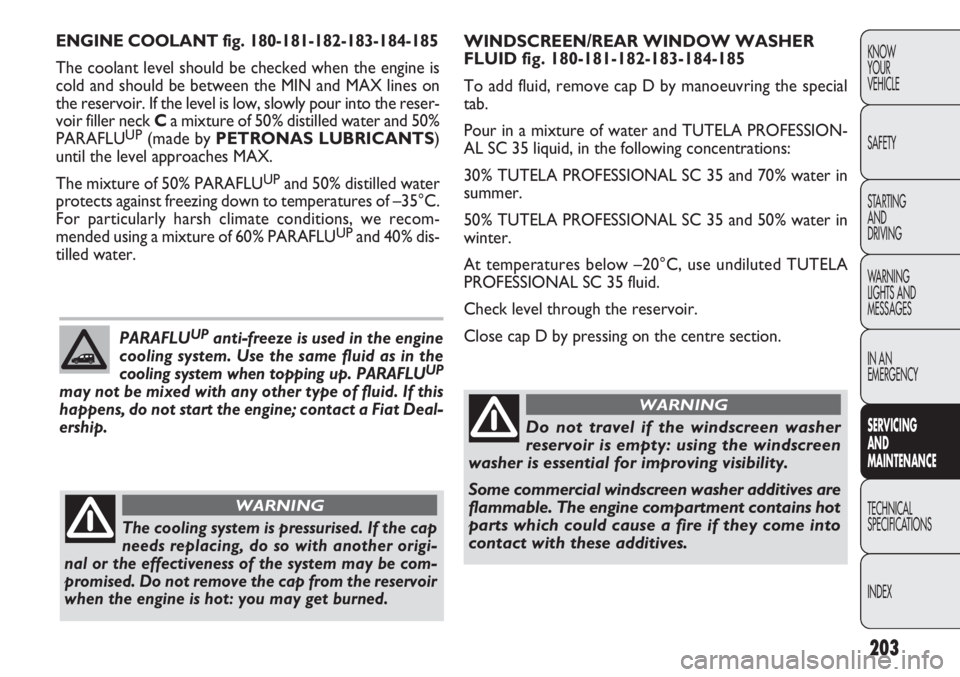
203
KNOW
YOUR
VEHICLE
SAFETY
STARTING
AND
DRIVING
WARNING
LIGHTS AND
MESSAGES
IN AN
EMERGENCY
SERVIC
ING
AND
MAINTENANCE
TECHNICAL
SPECIFICA TIONS
INDEX
WINDSCREEN/REAR WINDOW WASHER
FLUID fig. 180-181-182-183-184-185
To add fluid, remove cap D by manoeuvring the special
tab.
Pour in a mixture of water and TUTELA PROFESSION-
AL SC 35 liquid, in the following concentrations:
30% TUTELA PROFESSIONAL SC 35 and 70% water in
summer.
50% TUTELA PROFESSIONAL SC 35 and 50% water in
winter.
At temperatures below –20°C, use undiluted TUTELA
PROFESSIONAL SC 35 fluid.
Check level through the reservoir.
Close cap D by pressing on the centre section.
ENGINE COOLANT fig. 180-181-182-183-184-185
The coolant level should be checked when the engine is
cold and should be between the MIN and MAX lines on
the reservoir. If the level is low, slowly pour into the reser-
voir filler neck C
a mixture of 50% distilled water and 50%
PARAFLU
UP(made by PETRONAS LUBRICANTS )
until the level approaches MAX.
The mixture of 50% PARAFLU
UPand 50% distilled water
protects against freezing down to temperatures of –35°C.
For particularly harsh climate conditions, we recom-
mended using a mixture of 60% PARAFLU
UPand 40% dis-
tilled water.
PARAFLU
UPanti-freeze is used in the engine
cooling system. Use the same fluid as in the
cooling system when topping up. PARAFLU
UP
may not be mixed with any other type of fluid. If this
happens, do not start the engine; contact a Fiat Deal-
ership.
The cooling system is pressurised. If the cap
needs replacing, do so with another origi-
nal or the effectiveness of the system may be com-
promised. Do not remove the cap from the reservoir
when the engine is hot: you may get burned.
WARNING
Do not travel if the windscreen washer
reservoir is empty: using the windscreen
washer is essential for improving visibility.
Some commercial windscreen washer additives are
flammable. The engine compartment contains hot
parts which could cause a fire if they come into
contact with these additives.
WARNING
Page 215 of 283
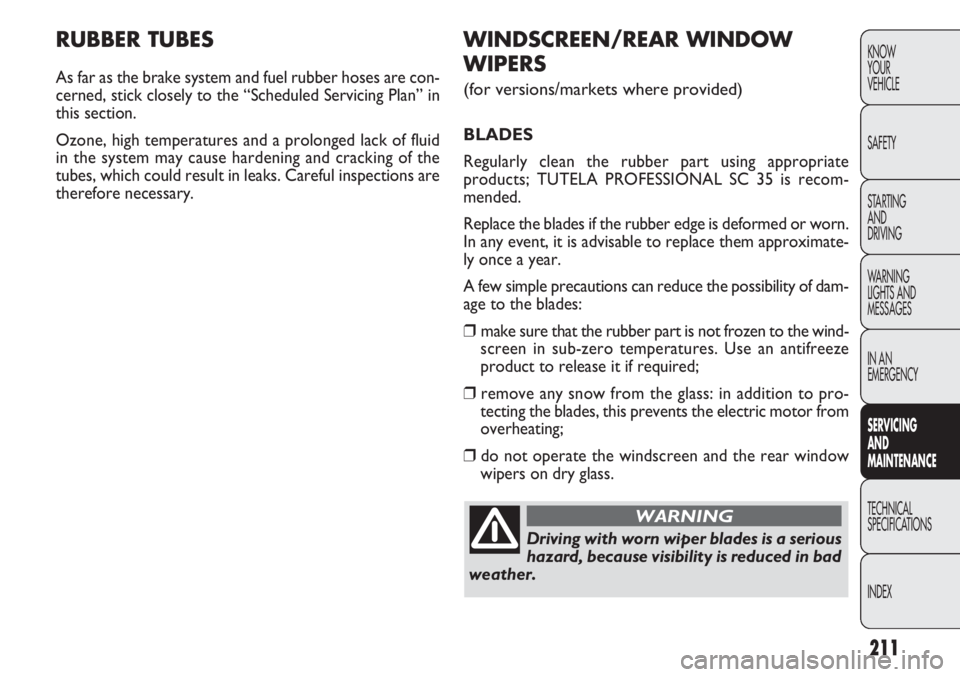
211
KNOW
YOUR
VEHICLE
SAFETY
STARTING
AND
DRIVING
WARNING
LIGHTS AND
MESSAGES
IN AN
EMERGENCY
SERVIC
ING
AND
MAINTENANCE
TECHNICAL
SPECIFICA TIONS
INDEX
RUBBER TUBES
As far as the brake system and fuel rubber hoses are con-
cerned, stick closely to the “Scheduled Servicing Plan” in
this section.
Ozone, high temperatures and a prolonged lack of fluid
in the system may cause hardening and cracking of the
tubes, which could result in leaks. Careful inspections are
therefore necessary.
WINDSCREEN/REAR WINDOW
WIPERS
(for versions/markets where provided)
BLADES
Regularly clean the rubber part using appropriate
products; TUTELA PROFESSIONAL SC 35 is recom-
mended.
Replace the blades if the rubber edge is deformed or worn.
In any event, it is advisable to replace them approximate-
ly once a year.
A few simple precautions can reduce the possibility of dam-
age to the blades:
❒ make sure that the rubber part is not frozen to the wind-
screen in sub-zero temperatures. Use an antifreeze
product to release it if required;
❒ remove any snow from the glass: in addition to pro-
tecting the blades, this prevents the electric motor from
overheating;
❒ do not operate the windscreen and the rear window
wipers on dry glass.
Driving with worn wiper blades is a serious
hazard, because visibility is reduced in bad
weather.
WARNING
Page 216 of 283
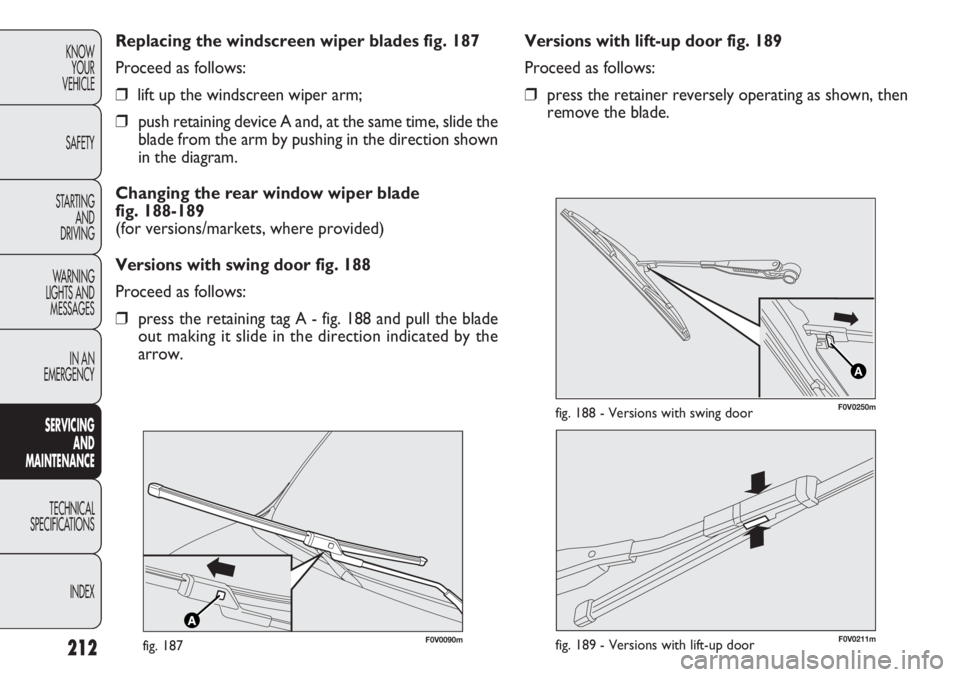
212
KNOWYOUR
VEHICLE
SAFETY
STARTING AND
DRIVING
WARNING
LIGHTS AND MESSAGES
IN AN
EMERGENCY
SERV IC
ING
AND
MAINTENANCE
TECHNICAL
SPECIFICA TIONS
INDEX
Versions with lift-up door fig. 189
Proceed as follows:
❒ press the retainer reversely operating as shown, then
remove the blade.
Replacing the windscreen wiper blades fig. 187
Proceed as follows:
❒
lift up the windscreen wiper arm;
❒ push retaining device A and, at the same time, slide the
blade from the arm by pushing in the direction shown
in the diagram.
Changing the rear window wiper blade
fig. 188-189
(for versions/markets, where provided)
Versions with swing door fig. 188
Proceed as follows:
❒ press the retaining tag A - fig. 188 and pull the blade
out making it slide in the direction indicated by the
arrow.
F0V0090mfig. 187F0V0211mfig. 189 - Versions with lift-up door
A
F0V0250mfig. 188 - Versions with swing door